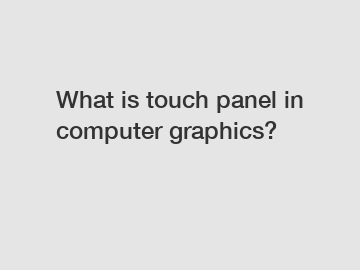Nov. 29, 2023
Consumer Electronics
What is touch panel in computer graphics?
In today's world, computer graphics play a crucial role in various industries such as design, gaming, animation, and even education. One aspect that has significantly enhanced the user experience when interacting with graphics is the touch panel. A touch panel is a user interface technology that allows users to interact with computer graphics through touch gestures and commands. This article will explore the concept of touch panels in computer graphics, their functionality, and their relevance in today's digital age.
Understanding touch panels.

A touch panel is a display overlay that is sensitive to touch. It is usually placed on top of a display screen, be it a computer monitor, laptop, smartphone, or tablet. The primary purpose of a touch panel is to convert the user's touch into input signals that the computer can recognize and interpret. This enables users to perform various actions such as selecting objects, dragging and dropping, zooming in and out, and scrolling, all by simply touching the screen.
Types of touch panels.
There are several types of touch panels available in the market, each utilizing different technologies to detect and respond to touch gestures. Some common types include:
1. Resistive touch panels: These panels consist of two layers with a small gap between them. When the screen is pressed, the layers come into contact, and the touch location is detected by measuring the resistance changes at that point. Resistive touch panels are known for their durability and affordability.
2. Capacitive touch panels: Capacitive panels are made up of a layer of glass coated with a conductive material. When a finger touches the screen, it disrupts the screen's electrostatic field, allowing the touch location to be detected. Capacitive touch panels are highly responsive and offer multi-touch capabilities.
3. Infrared touch panels: Infrared panels use a grid of infrared beams across the screen's surface. When an object touches the screen, it interrupts the beams, and the touch location is determined. Infrared touch panels are known for their high accuracy and can work with any input method.
4. Optical touch panels: These panels use infrared cameras to detect touch input. The cameras track the movement of an object or finger on the screen and register the touch location. Optical touch panels offer excellent touch accuracy and are often used in large interactive displays.
The relevance of touch panels in computer graphics.
Touch panels have revolutionized the way users interact with computer graphics. They provide a more intuitive and immersive experience, allowing users to directly manipulate objects on the screen using their fingers. This makes tasks such as drawing, editing, and navigating through complex graphic interfaces much easier and user-friendly. Touch panels have also made it possible to develop interactive and engaging applications and games that respond to touch gestures, enhancing user engagement and enjoyment.
In conclusion, touch panels in computer graphics have become an essential component in today's digital age. They offer a more interactive and user-friendly experience, enabling users to directly interact with graphics using touch gestures. With advancements in technology, touch panels will continue to evolve and play a significant role in enhancing the way we interact with computer graphics.
If you have any further questions or would like to know more about touch panels in computer graphics, please do not hesitate to contact us.
For more Touch Panel Manufacturer in Japan, 17 Touch Panel Manufacturer, Ilitek Touchscreeninformation, please contact us. We will provide professional answers.
If you are interested in sending in a Guest Blogger Submission,welcome to write for us!
All Comments ( 0 )